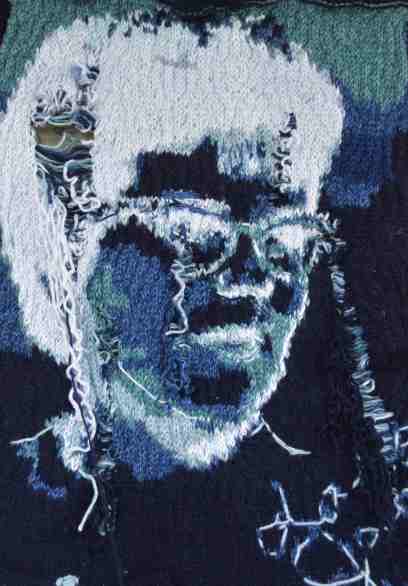"Up The River" by Stephanie Tanner, Mixed Media Fiber Art Metal, Wool, Driftwood, 12x60in, 2018, $600
Stephanie Tanner makes sculptures that scream out to be touched. The tactile quality of the wool she often uses is particularly alluring, but more importantly, the pieces communicate an emotional intensity that is utterly compelling.
"Holding Fast" by Stephanie Tanner, Concrete, Wool, Wood, 8x22x18in, 2018, $250
“I like to think of myself as a woven word artist,” explains Tanner, “a poet that wants to hold words in my hands and show how they appeared as I wrote them. I write passionately about love, loss, longing, and mental illness. My rendering of each poem uses discarded household objects, concrete sculpture and various types of fiber (wool, yarn, fabric etc.) to move the poem from paper into this dimension.”
The recognizable objects are filled with fabric situated in forms and patterns suggestive of the ordinary contents or attachments, but the softness of the materials, including the delicate interplay of pastel colors that suggest Baroque paintings, lends a dream-like quality to the sculptures. Tanner’s formal education may have not included an art degree, but her work is nonetheless filled with academic references from history, even while it expresses complex emotional states that reflect.
“I am stubbornly self-taught in that I learned my techniques through a great deal of curiosity and experimentation. There is never a sketch or a plan…just the thought ‘I wonder what would happen if I did… X?’ and then surrender myself fully until it tells me it is finished. My goal is to bridge the gap between poetry and visual art and create a fuller sensory experience.”
“I loved the people I worked for but found the 9-5 life unfulfilling. I quit in 2008 after the birth of my daughter and jumped head first into art, pursuing a career as a professional photographer. After 9 years of photographing weddings, babies, and families my heart once again felt restless and I felt a desire to further push my creative limits. I began exploring all kinds of artistic mediums but none of them felt right for me. I had always written poetry but in 2016 I began weaving as a way to battle my chronic depression and anxiety and it quickly moved from a hobby to a full-time passion. Recently I have been working on larger pieces that incorporate my poetry, weaving, and found objects.”
On September 29, Tanner will be part of the Louisville Visual Art’s Juried Exhibit in the 2018 Portland Art & Heritage Fair. The exhibit will be available for viewing at the Marine Hospital from 11am-5pm. Jury prizes will be awarded at 2:00pm.
Hometown: Grew up in Germany, Alabama, South Carolina, Rhode Island and Pennsylvania. But for the last 15 years, I have called Louisville my home.
Education: Degree in Hospitality Management, MBA, Johnson and Wales University
Website: www.iamstephtanner.com
Instagram: iamstephtanner
Scroll down for more images
"Starships" by Stephanie Tanner, Wool, antique fish basket, 24x18in, 2018, $300
“Nowhere to Keep This” by Stephanie Tanner, Wool, vintage suitcase, 26x20in, 2018, $425
Written by Keith Waits. Entire contents copyright © 2018 Louisville Visual Art. All rights reserved. In addition to his work at the LVA, Keith is also the Managing Editor of a website, Arts-Louisville.com, which covers local visual arts, theatre, and music in Louisville.




































